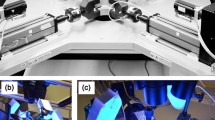Abstract
Insight into the role of triaxiality in mode-I, plane strain resistance curves of a representative ductile metal has been gained. Growth of a macroscopic crack is simulated as per modified boundary layer formulation for a range of constraint parameter with the fracture process represented by a triaxiality dependent cohesive model. In contrast to the predictions by a fixed cohesive law, the study shows that by including the effect of triaxiality on the work of separation, the stick-slip nature or the non-uniformity in the rate of the crack growth and its manifestations on the plastic wake and fracture surface can be predicted that are closer to trends observed in experimental literature.















Similar content being viewed by others
References
Anvari M, Scheider I, Thaulow C (2006) Simulation of dynamic ductile growth using strain-rate and triaxiality dependent cohesive elements. Eng Fract 73(15):2210–2228
Banerjee A, Manivasagam R (2009) Triaxiality dependent cohesive zone model. Eng Fract Mech 76:1761–1770
Broberg KB (1995) Critical review of some methods in nonlinear fracture mechanics. Eng Fract Mech 50:157–164
Cornec A, Scheider I, Schwalbe KH (2003) On the practical application of the cohesive model. Eng Fract Mech 70:1963–1987
Gao YF, Bower AF (2004) A simple technique for avoiding convergence problems in finite element simulations of crack nucleation and growth on cohesive interfaces. Model Simul Mater Sci Eng 12:453–463
Hancock JW, Reuter WG, Parks DM (1993) Constraint and toughness parameterized by T. ASTM Special Tech Publ 1171:21–21
Jha D, Banerjee A (2012) A cohesive model for fatigue failure in complex stress-states. Int J Fat 36(1):155–162
Needleman A (1987) A continuum model for void nucleation by inclusion debonding. J Appl Mech 54:525–531
Ostby E, Thaulow C, Zhang ZL (2007) Numerical simulations of specimen size and mismatch effects in ductile crack growthPart I: tearing resistance and crack growth paths. Eng Fract Mech 74(11):1770–1792
Pineau A (2008) Modeling ductile to brittle fracture transition in steels-micromechanical and physical challenges. Int J Fract 150(1–2):129–156
Rashid FM, Banerjee A (2013) Implementation and validation of a triaxiality dependent cohesive model: experiments and simulations. Int J Fract 181(2):227–239
Scheider I, Rajendran M, Banerjee A (2011) Comparison of different stress-state dependent cohesive zone models applied to thin-walled structures. Eng Fract Mech 78(3):534–543
Siegmund T, Brocks W (1999) Prediction of the work of separation and implications to modeling. Int J Fract 99:97–116
Siegmund T, Brocks W (2000) A numerical study on the correlation between the work of separation and the dissipation rate in ductile fracture. Eng Fract Mech 67:139–154
Stampfl J, Kolednik O (2000) The separation of the fracture energy in metallic materials. Int J Fract 101(4):321–345
Stampfl J, Scherer S, Berchthaler M, Gruber M, Kolednik O (1996) Determination of the fracture toughness by automatic image processing. Int J Fract 78(1):35–44
Sumpter JDG (1999) An alternative view of R-curve testing. Eng Fract Mech 64:161–176
Tatschl A, Kolednik O (2003) A new tool for the experimental characterization of micro-plasticity. Mat Sci Eng A 339(1):265–280
Turner CE, Kolednik O (1994) A micro and macro approach to the energy dissipation rate model of stable ductile crack growth. Fatig Fract Eng Mater Struct 17:1089–1107
Tvergaard V, Hutchinson JW (1992) The relation between crack growth resistance and fracture process parameters in elastic–plastic solids. J Mech Phys Solids 40:1377–1397
Tvergaard V, Hutchinson JW (1994) Effect of T-stress on mode I crack growth resistance in a ductile solid. Int J Solids Struct 31(6):823–833
Varias AG (1998) Constraint effects during stable transient crack growth. Comput Mech 21:316–329
Acknowledgments
The authors gratefully acknowledge the financial support provided by Aeronautics Research and Development Board (ARDB), India. (Grant no: DARO/08/1051582/M/I) to carry out the research work.
Author information
Authors and Affiliations
Corresponding author
Rights and permissions
About this article
Cite this article
Kanhurkar, N., Rashid, F.M. & Banerjee, A. On the role of triaxiality in mode-I resistance curves. Int J Fract 188, 59–70 (2014). https://doi.org/10.1007/s10704-014-9946-4
Received:
Accepted:
Published:
Issue Date:
DOI: https://doi.org/10.1007/s10704-014-9946-4




